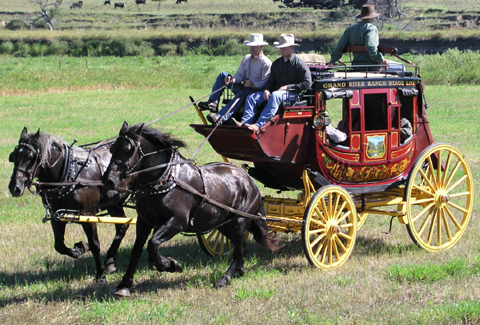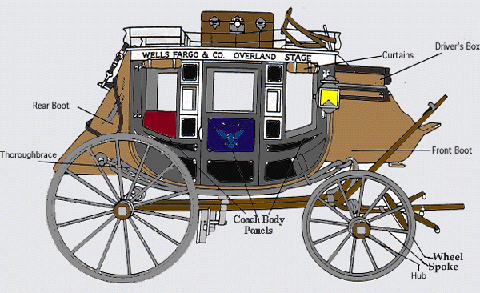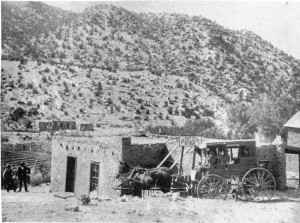
The stagecoach is an extremely well known image (thank you Wells Fargo Bank). The four-wheeled closed coach for passengers, drawn by four horses was widely used before the arrival of railroads. The business of running stagecoaches was known as staging. The stagecoach was supported on thoroughbraces, which were leather straps supporting the body of the carriage and serving as springs. We think of the stage coach as a western item but it was actually invented in England.
From Wikipedia:
“The first Concord stagecoach was built in 1827. Abbot Downing Company employed leather strap braces under their stagecoaches which gave a swinging motion instead of the jolting up and down of a spring suspension. The company manufactured over forty different types of carriages and wagons at the wagon factory in Concord, New Hampshire. The Concord Stagecoaches were built so solidly that it became known that they didn’t break down but just wore out. The Concord stagecoach sold throughout South America, Australia, and Africa. Over 700 Concord stagecoaches were built by the original Abbot Downing Company before it disbanded in 1847. Mark Twain stated in his 1861 book Roughing It that the Concord Stagecoach was like “a cradle on wheels”.

“The term “stage” originally referred to the distance between stations on a route, the coach traveling the entire route in “stages,” but through constant misuse it came to apply to the coach. A stagecoach could be any four wheeled vehicle pulled by horses or mules – the primary requirement being that it was used as a public conveyance, running on an established route and schedule. Vehicles included buckboards and dead axle wagons, surplus Army ambulances, celerity [or mud] coaches, and the deluxe Concord. Selection of the vehicle was made by the owner of the stage line, and he would choose the most efficient vehicle based upon the load to be carried, the road conditions, and the weather; and used a two, four or six-horse team based upon those factors and the type of car.
 “The ballad, “The California Stage Company” only slightly exaggerates the travel conditions of the stagecoach passengers on the bad roads of early California. In coaches with three bench seats, the passengers rode three abreast squeezed into a space of 15 inches apeice. Back and middle rows, both faced forward, and a forward row, faced rearward. Those in the forward and middle rows had to ride with their knees dovetailed. On the center seat passengers had only a leather strap to support their backs on a long journey. Passengers rode with baggage on their laps and sometimes mail pouches beneath their feet. Some travelers suffered from motion sickness due to the motion of the coaches, aggravated when the coach traveled over a section of rough road, adding the torment of bouncing on the hard seat, against the roof, or against the side of the coach.
“The ballad, “The California Stage Company” only slightly exaggerates the travel conditions of the stagecoach passengers on the bad roads of early California. In coaches with three bench seats, the passengers rode three abreast squeezed into a space of 15 inches apeice. Back and middle rows, both faced forward, and a forward row, faced rearward. Those in the forward and middle rows had to ride with their knees dovetailed. On the center seat passengers had only a leather strap to support their backs on a long journey. Passengers rode with baggage on their laps and sometimes mail pouches beneath their feet. Some travelers suffered from motion sickness due to the motion of the coaches, aggravated when the coach traveled over a section of rough road, adding the torment of bouncing on the hard seat, against the roof, or against the side of the coach.
“Coaches on the Overland stages traveled continuously for twenty two days, day and night, through dust or blowing sand, in intense heat or cold, sometimes tormented by insects, with only brief stops at way stations to change teams, passengers often had poor food and no rest. If a passenger got off the stage to rest, he might be stuck in that place for a week or more, and only if the next stage had a seat not occupied by another. Passengers were sometimes compelled to walk to relieve the fatigued teams or when the coach had to be lightened to make it over a streach of sand or to help push coaches up hill or extricate them when bogged down in mud or sand. Passengers crowded into coaches caused conditions that prompted Wells Fargo to post these rules in each coach for passenger behavior:
 -Abstinence from liquor is requested, but if you must drink share the bottle. To do otherwise makes you appear selfish and unneighborly.
-Abstinence from liquor is requested, but if you must drink share the bottle. To do otherwise makes you appear selfish and unneighborly.
-If ladies are present, gentlemen are urged to forego smoking cigars and pipes as the odor of same is repugnant to the gentler sex. Chewing tobacco is permitted, but spit with the wind, not against it.
-Gentlemen must refrain from the use of rough language in the presence of ladies and children.
-Buffalo robes are provided for your comfort in cold weather. Hogging robes will not be tolerated and the offender will be made to ride with the driver.
-Don’t snore loudly while sleeping or use your fellow passenger’s shoulder for a pillow; he or she may not understand and friction may result.
-Firearms may be kept on your person for use in emergencies. Do not fire them for pleasure or shoot at wild animals as the sound riles the horses.
-In the event of runaway horses remain calm. Leaping from the coach in panic will leave you injured, at the mercy of the elements, hostile Indians and hungry coyotes.
-Forbidden topics of conversation are: stagecoach robberies and Indian uprisings.
-Gents guilty of unchivalrous behavior toward lady passengers will be put off the stage. It’s a long walk back. A word to the wise is sufficient.
“Passengers for the long haul overland coaches were given recommendations of equipment to be taken. For the earliest line that traveled through New Mexico Territory, the Jackass Mail, it was suggested: “One Sharps rifle and 100 rounds, a Colt (revolver) and two pounds of lead, a knife, a pair of thick wool pants, a half dozen pairs of thick socks, six undershirts, three overshirts, a wide-awake hat, a cheap sack coat, an overcoat, one pair of blankets in summer and two in winter, gauntlets, needles, pins, a sponge, hair brush, comb, soap, two pairs of thick drawers, and three or four towels.”
 Here in New Mexico the first stagecoach run was from Independence, Missouri on July 1, 1850, bound for New Mexico’s capital over the Santa Fe Trail. Riders paid a $100 fare for the trip that covered almost 800 miles. Initially, service was only once a month. Then in 1858, the schedule became weekly, and finally triweekly in 1866. Operation was financially possible only because of a government subsidy to deliver the mail to Santa Fe.
Here in New Mexico the first stagecoach run was from Independence, Missouri on July 1, 1850, bound for New Mexico’s capital over the Santa Fe Trail. Riders paid a $100 fare for the trip that covered almost 800 miles. Initially, service was only once a month. Then in 1858, the schedule became weekly, and finally triweekly in 1866. Operation was financially possible only because of a government subsidy to deliver the mail to Santa Fe.
A second long-distance stage line, the Overland Mail Co., began service between St. Louis and San Francisco in 1858, and passed through Southern New Mexico. Incredibly, it covered the 2,800-mile route in just 25 days. Stagecoaches on the Santa Fe Trail lasted for 30 years, not being extinguished until 1880 when railroad tracks reached Santa Fe. At that point, stagecoaching in New Mexico took a different turn. Short-haul stage companies sprang to life, collecting passengers at the railroad towns and delivering them to remote communities and mining camps.
If you have problems seeing the video below click HERE
.youtube::BypxgtXO82w::
